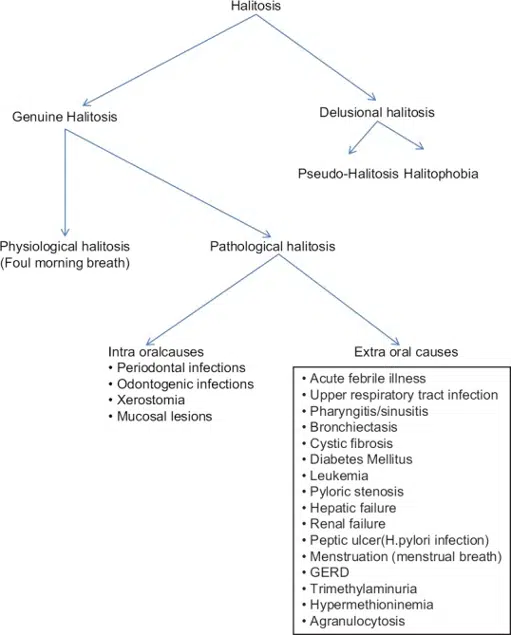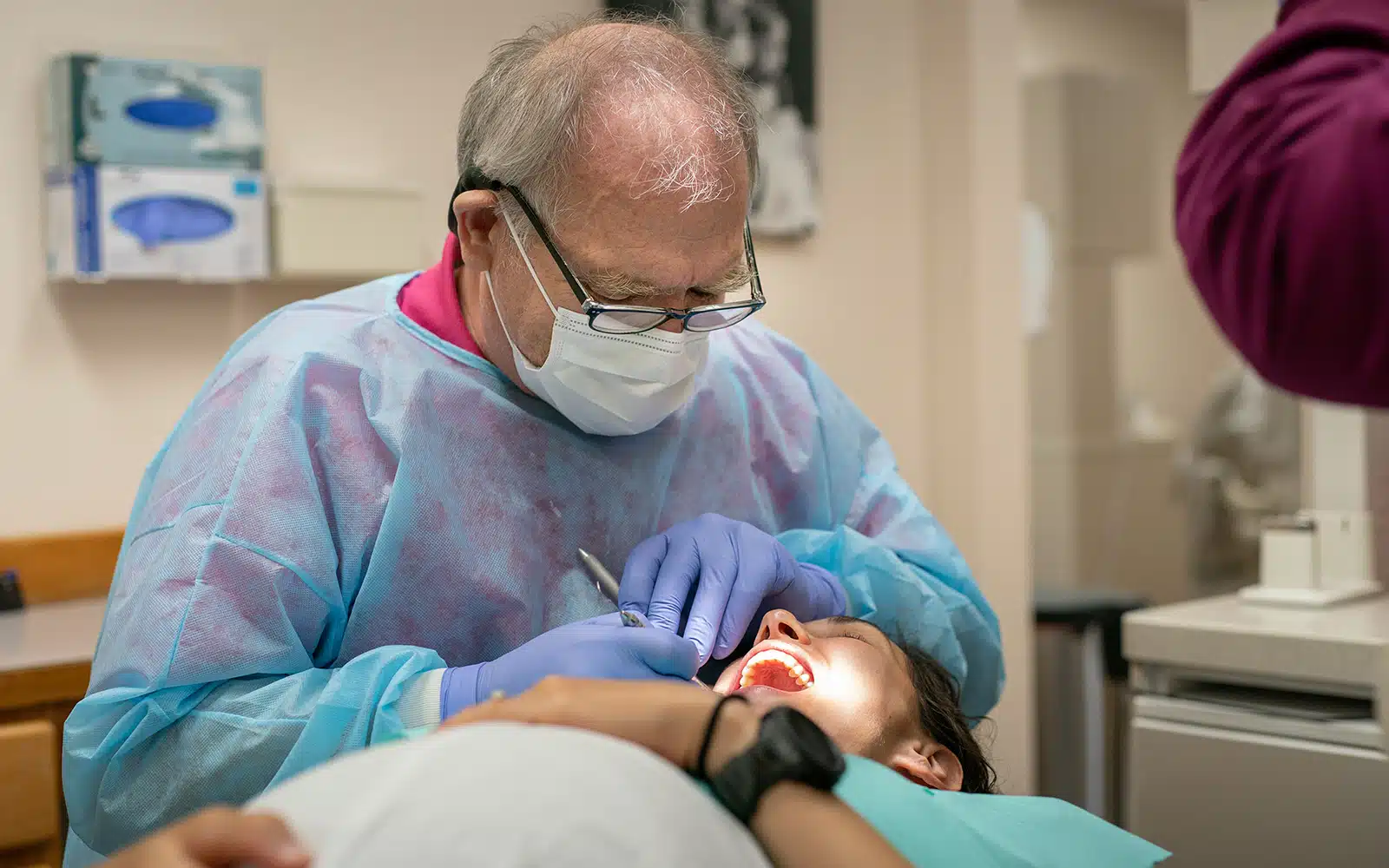- Many medical conditions cause halitosis.
- Accurate clinical measurement and identification of the volatile compounds producing halitosis is necessary to treat the problem effectively.
- Halitosis is curable in nearly 100% of all cases.
Halitosis, or bad breath, has long been neglected by healthcare professionals, and there is less scientific data on the subject. However, many patients are now approaching health practitioners because they experience social and psychological disadvantages that affect their relationships with other people. The growing concern about halitosis is also driven by media attention. A proper diagnosis is crucial to finding the cause and suggesting effective solutions.
What is Halitosis?
Halitosis, or bad-smelling breath, is a symptom that a wide range of health problems can cause. It can occur in all genders and ages, but a Turkish study reports that older people can have stronger intensity halitosis.
The prevalence of the problem seems to vary geographically. Halitosis occurs in nearly half the population in the USA, 6 to 23 percent of Chinese, 21 to 35 percent of Indians, and only in 2 percent of Swedish men.
Halitosis is caused by volatile molecules, such as sulfur, aromatic, phenyl, aliphatic compounds, amines, short-chain fatty acids, alcohols, or nitrogen-containing compounds. The chemicals involved depend on the cause of bad breath.
Types of Halitosis
Bad breath doesn’t smell the same. According to Healthline, the smell depends on the causes listed below.
Sweet or fruit malodor is caused by:
- Dieting or fasting that involves low carbohydrates leads to the breakdown of fat and the production of strong-smelling ketones.
- Diseases like diabetic ketoacidosis.
The rotten or decaying-smelling halitosis is caused by:
- Nose, throat, sinuses, and oral infections or inflammation.
- Food stuck between teeth.
- Poor dental hygiene and unclean dentures can result in bacteria buildup or plaque, leading to periodontitis.
- Diseases like bronchiectasis, gum disease, and granulomatosis.
Breath like nail polish remover is caused by:
- A low carbohydrate diet, where the body burns fats to produce acetone.
- Diseases like diabetes.
Sour-smelling breath is due to:
- Problems like gastroesophageal reflux disease (GERD).
Breath smells like feces because:
- Of bowel blockage that prevents movement of waste. Other symptoms like bloating, cramping, vomiting, and constipation accompany it. The condition needs immediate medical attention.
Breath smells of ammonia or urine due to:
- Damage or injury to kidneys.
Breath smells musty due to the following:
- Liver diseases, including cirrhosis.
Malodor smells like maple syrup:
- If the patient cannot metabolize some amino acids. If untreated, it can cause serious health problems.
Breath smells fishy:
- This is due to an enzyme disorder that makes sweat, breath, and other bodily fluids smell fishy.
Breath smells like sweaty feet:
- Of an enzyme disorder that can’t break down proteins into amino acids.
- Diseases in infants like Isovaleric acidemia.
Breath like boiled cabbage due to:
- A genetic disorder called hypermethioninemia, where the person can’t metabolize methionine, an amino acid.
External factors and other causes for halitosis include:
- Tobacco products and smoking.
- Foreign items stuck in the noses of children.
- Dry mouth due to disease causes odor buildup, as the saliva necessary to clean mouths does not exist.
- Medications can reduce saliva and lead to malodor. Or the breakdown of the medicines produces smelly compounds.
Diagnostic and Halitosis Treatment
Identifying the cause of halitosis is essential to treating this preventable condition because of the wide range of medical reasons that cause bad breath.
Of the various medical conditions that cause bad breath,
- About 90 percent of halitosis is due to oral reasons.
- Around 9 percent of cases are caused by non-oral problems.
- And 1 percent of halitosis is caused by drugs or diets.
Diagnosing halitosis is the first step.
Patients approach medical practitioners based on self-assessment or other people’s assessment. Dentists will usually consider the patients’ main complaints (frequency, duration, timing), dental and medical history, diet, and habits to diagnose halitosis.

Figure 1: The different methods of halitosis measurement, Aydin et al. 2016. (Image credits https://www.researchgate.net/publication/298422154_ Diagnostic_Value_of_Halitosis_Examination_Methods)
Dentists check three malodor sources- the mouth, breath, and nasal cavity, to establish halitosis and its intensity. Several methods are available; see Figure 1.
Organoleptic assessment: This is the simplest means of evaluation. The breath is smelt directly or after collection in a bag, examining the scrapings from the back of the tongue and the nose. This allows professionals to establish bad breath and rate it from 0 to 5, with zero for no halitosis. Organoleptic assessment can detect a wide range of odors but is subjective and not quantifiable. It is not suitable as a stand-alone diagnostic tool.
Halitometry instruments: Halitometers are sophisticated detectors that quantify gases precisely but not halitosis itself. They identify volatile sulfur compounds (VSC), like hydrogen sulfide, dimethyl sulfide, methyl mercaptan, and other thiols. Halimeter and Gas chromatography can detect sulfur levels but not volatiles, like cadaverine and putrescine.
Enzymatic tests are chemical tests that measure the metabolic products of bacteria or enzyme levels in the mouth. For example, the BANA tests enzymes produced by bacteria, and beta-galactosidase tests confirm mouth odor.
The Diagnosis

Figure 2: “A schematic representation of the classification of halitosis,” Kapoor et al. 2016. (Image credits: 10.4103/1305-7456.178294)
After checking the mouth and nose, the dentist will decide what type of halitosis the patient suffers; see Figure 2.
- Malodor from the mouth but not the nose indicates the cause is oral or pharyngeal.
- Odor only from the nose is due to sinuses or nose ailments.
- Bad breath of the same intensity from the mouth and nose, which is rare, indicates a systemic problem requiring further and complete examination of the patients.
- No malodor detectable in the clinic is diagnosed as delusional halitosis
If halitosis is due to oral causes, the dentists suggest dental cleaning, oral hygiene, or medicines for oral infections. If the dentists find no possible cause in the mouth or nose, they will refer the patient for further checks to other specialists.
Dentists or medical practitioners are the best sources for information, diagnosis, or treatment of halitosis. Reading material on possible treatments is available at Healthline, WebMD, etc.
Staying Informed About Halitosis Treatment
Many medical and dental practitioners are not adequately informed about halitosis causes, diagnostics, and treatments. The Halimeter® produced by Interscan measures trace amounts of volatile sulfur compounds in parts per billion (ppb). The levels of the three gases are reported together. Interscan’s original Halimeter®, which was introduced in 1997, was the first instrument designed for clinical measurement of VSCs. Hundreds of dentists trust the Halimeter®, and the FDA has cleared it for export.
 Vijayalaxmi Kinhal
Vijayalaxmi Kinhal
Science Writer, CID Bio-Science
Ph.D. Ecology and Environmental Science, B.Sc Agriculture
Sources
Aydin, Murat & Bollen, Curd & Ozen, Murat. (2016). Diagnostic Value of Halitosis Examination Methods. Compendium of continuing education in dentistry (Jamesburg, N.J.: 1995). 37. 174-178; 80. https://www.researchgate.net/publication/298422154_Diagnostic_Value_of_Halitosis_Examination_Methods
Aylıkcı, B. U., & Colak, H. (2013). Halitosis: From diagnosis to management. Journal of natural science, biology, and medicine, 4(1), 14–23. https://doi.org/10.4103/0976-9668.107255
Cleveland Clinic.org. (2022 July 18). Bad Breath (Halitosis). https://my.clevelandclinic.org/health/diseases/17771-bad-breath-halitosis
John Hopkins Medicine. (n.d.). Halitosis (Bad Breath). Retrieved from https://www.hopkinsmedicine.org/health/conditions-and-diseases/halitosis-bad-breath
Guedes, C. C., Bussadori, S. K., Garcia, A. C. M., Motta, L. J., Gomes, A. O., Weber, R., & Amancio, O. M. S. (2020). Accuracy of a portable breath meter test for the detection of halitosis in children and adolescents. Clinics (Sao Paulo, Brazil), 75, e1764. https://doi.org/10.6061/clinics/2020/e1764
Kapoor, U., Sharma, G., Juneja, M., & Nagpal, A. (2016). Halitosis: Current concepts on etiology, diagnosis and management. European journal of dentistry, 10(2), 292–300. https://doi.org/10.4103/1305-7456.178294
Newman, T. (2018, January 10). Everything you need to know about bad breath. Retrieved https://www.medicalnewstoday.com/articles/166636
Stanborough, R. J. (2023, Feb 3). What Causes Common Types of Bad Breath Smells? Retrieved from https://www.healthline.com/health/types-of-bad-breath-smells
Szalai, E., Tajti, P., Szabó, B., et al. (2023). Organoleptic and halitometric assessments do not correlate well in intra-oral halitosis: a systematic review and meta-analysis. Journal of Evidence-Based Dental Practice, 101862.


